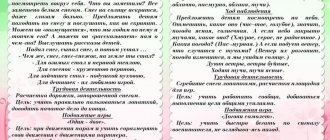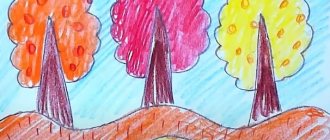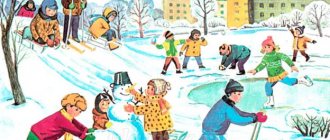Planning walks in the middle group according to the Federal State Educational Standard
Let's look at the file of observation walks for the middle group of preschool educational institutions. In order for the walks to be interesting and at the right pace, it is necessary to draw up a plan and preliminary preparation on various topics.
Walk 1 – Autumn Tree Watching
Goal: learn to find distinctive features of trees in autumn compared to summer. To see extraordinary beauty in the autumn colors of trees.
Progress of observations: read the poem by A. S. Pushkin “Dull Time”.
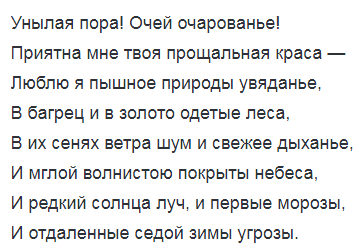
Observe different trees with children. Find differences and similarities in the color of autumn leaves of oak, maple, birch, and rowan. Draw children's attention to the special beauty of the entire landscape in autumn, September, October, November.
Experience, experiment: collect beautiful autumn leaves for crafts on an autumn theme.
Outdoor game: competition with autumn fruits. Divide the children into two teams. Give each person one acorn (to the first team) and one chestnut (to the other team). From the beginning of the game, children from each team simultaneously run a race with their acorn (chestnut) to the marked place and throw it into the bucket. Those who run faster win. Physical exercise and reaction to speed will charge children with vigor and fun.
Walk 2 - Watching Snow During the Winter Months
Goal: learn to observe changes in nature in winter.
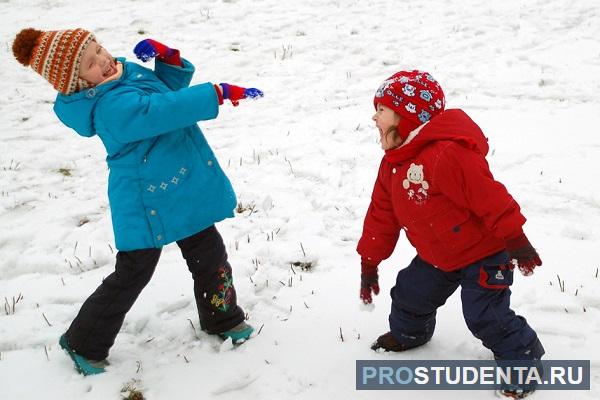
Progress of observations: note if snowfall means warming. Snowflakes crunch underfoot - frost. In winter it gets dark early - especially in December. In winter comes New Year and Christmas. Children sled, skate, ski, and play snowballs.
Experience, experiment: carrying out an analysis - measure the depth of a snowdrift in the sun and in the shade, offer independent activity to the baby.
Outdoor game: snowball fight. An active, cheerful game will warm children, give them a good mood, and teach them accuracy.
Walk 3 - watching a cat in the spring area of the garden
Goal: remember the characteristic signs of a cat, its habits, behavior.
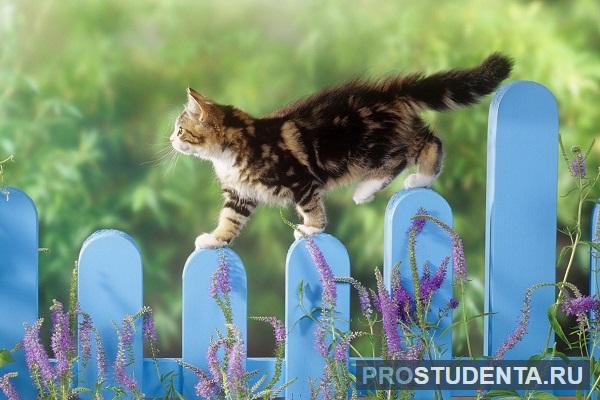
Progress of observations: read a poem about a cat, ask a riddle and ask which of the children knows poems about cats. Invite children to examine and describe the cat and its distinctive features. Talk about how spring affects cats (they become goulens). That with the arrival of spring, the cat's fur sheds lighter for the summer period. Build a dialogue with children in the form of a conversation.
Experience, experiment: try to play with a cat using a ribbon on a string. Warn children that they should not pick up unknown animals on the street.
Outdoor game: conducting physical education. Jumping on two legs while moving forward. Moving exercises have a beneficial effect on muscles.
Summary of an open event in the middle group. Outdoor autumn walk
Summary of an open event in the middle group.
Open autumn walk in the middle group.
Master Class.
Target
: To consolidate knowledge of the seasons. Learn to name and recognize birds. To form specific knowledge about seasonal phenomena in nature. Draw the attention of children that with the onset of cold weather, birds become colder and need to be fed. Teach children to play outdoor games following the rules, to run without bumping into each other, and to act on the teacher’s signal. Develop speech, thinking, memory, dexterity, speed. Enrich children's vocabulary with words. Cultivate a caring attitude towards birds. Foster hard work and independence.
Walking progress:
Children go for a walk. Educator:
Guys, let's read a poem about the sun.
“Sunny, sunshine, shine a little light. The children will come out for a walk, the children will come out to play.” Educator:
Look, guys, the sun has appeared.
Educator:
How is the sun shining?
— Does the sun warm our hands? Children: The sun is high. It doesn't heat well. Educator:
- What time of year is it now?
Children: Autumn. Educator
: What is the weather like today?
Children: Cool. Educator:
Why has the weather become cool?
Children: Winter will come soon. Educator:
What is our coldest autumn month?
Children: November. Educator
: Name the autumn months in order?
Children: September, October, November. -Surprise moment: A crow flew to visit us today. Educator:
Let's say hello to the crow.
Children: Hello crow. Educator
: Guys, why do you think the crow didn’t fly away with the rest of the birds to warmer climes?
Children: The crow is not afraid of frost; it spends the winter with us. Crow is a wintering bird. Educator:
Is it difficult for the birds that stay with us at this time of year or not?
Why? Children: It’s hard for birds. Because it becomes cold and hungry. Educator:
To make it easier for the birds with the onset of cold weather, let's hang a feeder for them on our site and feed them.
-What are we going to feed our birds? Children: Seeds, bread. — Together with the children, we pour seeds and bread crumbs into the feeder. Educator:
Look how the crow liked our feeder.
And other birds will definitely fly to our site. —What other birds do you know that winter with us? Children: Dove, sparrow, magpie, crow. Educator
: Well, now, let’s play a little game with you “Sparrows and the Car” And we’ll invite the guest to play with us.
“Sparrows and a car”
Goal: To teach children to run in different directions without bumping into each other.
Start moving and change it at the teacher’s signal. How to play: Children sit on a bench on one side of the playground. These are sparrows in nests. The teacher stands on the opposite side. it depicts a car. After the words of the teacher, “Let’s fly, sparrows, onto the path.” Children rise from the bench, run around the area, waving their arms and wings. At the teacher’s signal: “The car is moving, sparrows fly to their nests!” The car leaves the garage. The sparrows fly to the bench. The car returns to the garage. Note for the game: It is necessary to first show how sparrows peck grains and how they fly. The car should not move too fast to allow all the children to find their place on the bench. Educator:
Guys, did you like playing the game “Sparrows and the Car”?
Children: Yes Educator:
Look, our crow liked it too.
Educator:
Guys, listen to the poem that I will read to you about birds.
“Feed the birds in winter!
Let flocks of people flock to your porch from all over, as if it were home.
Their food is not rich, they need a handful of grain, one handful - and they won’t be afraid of winter. It’s hard to count how many of them are dying, it’s hard to see. But in our heart there is also warmth for the birds. How can we forget: They could have flown away, But they stayed to spend the winter Together with the people. Teach the birds to your window in the cold, So that we don’t have to welcome spring without songs.” Educator
: Guys, did you like the poem?
Educator
: What is this poem about?
Children: This is a poem about birds. How will you treat birds now? Children: Feed, protect. Educator
: Why do you need to protect birds?
Children: So that the birds sing songs to us in the spring and we are in a joyful mood. Educator:
Let's play some more with our guests in the area.
— I offer children games at will. Educator
: Well, now let's say goodbye to our guests.
Now our children know that birds need to be protected, helped and fed. And with the onset of spring, birds will bring us joy. They will sing wonderful and beautiful songs. Children: Goodbye. Educator
: Well, we guys need to work a little more.
Let's prepare our site for the cold season. Educator:
What time of year is coming soon?
Children: Winter will come soon. Educator:
Our walk today has come to an end.
-Did you like it? Children: Yes. Educator
: Who came to visit us at the site today?
Children: Crow. Educator:
Do you now know how to treat birds?
Children: Birds need to be looked after and fed. Well done boys. Children enter the group. Let's put all the toys in baskets and bring them into the group. Children:
Help the teacher clean up the area. Remove removed material. They bring him into the group.
Walk for children of the middle group “Autumn time”
Authors:
Milnichenko Tatyana Vasilievna,
Muslimova Liliya Rubilevna
educators
MADOU d/s No. 133, Tyumen
Target:
Summarize the signs of Autumn with your children. To foster cognitive interest in nature, to develop speech development in children. The desire to be in the fresh air, to learn to notice the beauty of nature. Loving her, trying to protect her from trash, learning to take care of her.
Objectives: - Help consolidate knowledge about trees, learn to identify trees by their characteristics, learn to distinguish the leaves of different trees; - Develop children's speech. — Enrich your vocabulary. - Train memory and attention. — Form a holistic picture of the natural world. — Foster concern for the environment.
Preliminary work:
Observing autumn nature, looking at trees, learning poems about autumn, reading works of art. Examination of a reproduction of Levitan’s painting “Golden Autumn”, as well as sketches and illustrations depicting various trees in autumn, collecting leaves on a walk.
Progress of the walk
If the leaves on the trees have turned yellow, If the birds have flown to a distant land, If the sky is gloomy, if the rain is pouring, This time of year is called autumn. Author: M. Khodyakova.
Observation:
Remind children that autumn has come. The whole ground was covered with leaves - everything around was yellow. That's why autumn is called yellow and golden. Draw the children's attention to how one leaf flies to the ground, the other spins, spins and slowly falls to the ground. Clarify that the leaves are light, so they fly to the ground slowly. The wind blew, and many leaves rustled to the ground - this is leaf fall.
Look at the leaves of different trees. Please note that the surface of the leaf blade varies from tree to tree.
Outdoor game "Falling Leaves"
The goal is to consolidate children’s knowledge about the color and size of autumn leaves. Reinforce the concept of “leaf fall.” Progress of the game. Children choose a leaf for themselves and name which leaf they chose based on size and color. Children run and wave their arms:
Leaf fall! Leaf fall! Yellow leaves are flying. (children with yellow leaves)
Leaf fall! Leaf fall! Red leaves are flying! (children with red leaves)
Beautiful yellow leaves are spinning! (children with yellow leaves)
Beautiful red leaves are spinning! (children with red leaves)
They sat down, sat down and froze.
A light breeze came and blew.
Leaves rose and scattered in different directions.
Spinning, spinning.
Leaf fall, leaf fall! Leaves are flying in the wind!
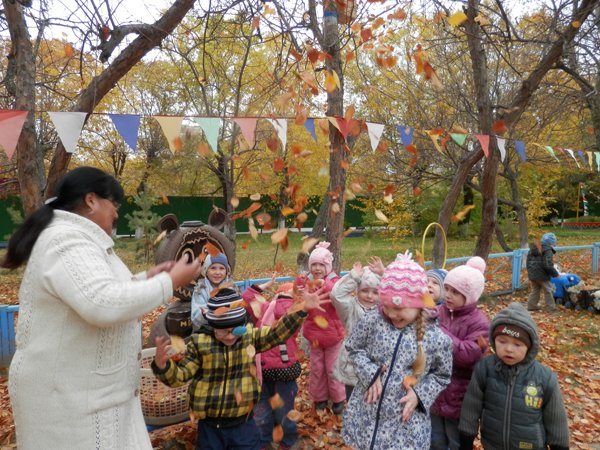
Outdoor game “ Run to the named tree.”
Goal: to train in quickly finding the named tree.
Progress of the game: The driver is selected. He names a tree, all children must listen carefully to which tree is named and, in accordance with this, run from one tree to another. The driver carefully monitors the children; whoever runs to the wrong tree leaves the game.
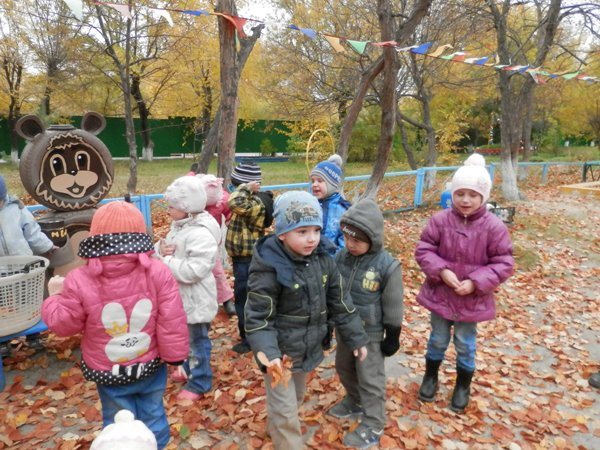
Sedentary game "Leaves"
Leaves are falling, falling - (Children are spinning, raising their arms up, squatting)
It's leaf fall in our garden. Yellow, red leaves (Spin again)
They curl and fly in the wind. Birds are flying south - (Running in a circle, waving their arms)
Geese, rooks, cranes. Now the last flock is flapping its wings in the distance.
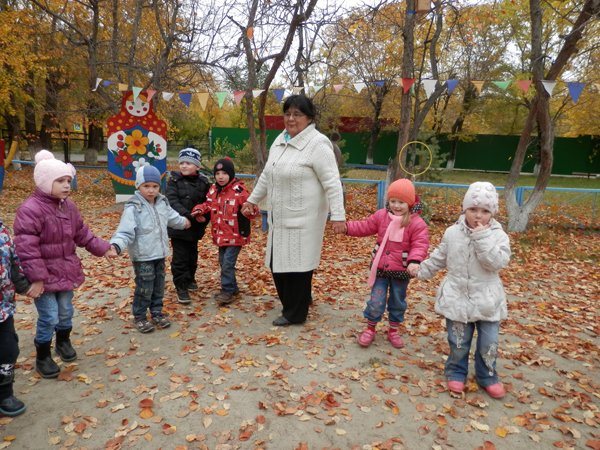
Guys, let's collect colorful leaves to make a beautiful panel out of them to decorate the group. (Children and their teachers collect leaves, discussing their color, shape and from which tree they fell).
Educator: Guys, what beautiful leaves you have. You liked the walk, you would like to come here again (children's answers). Unfortunately, it's time for us to go, well done to you all!
List of used literature:
1. Teplyuk S.N. Walking exercises in the middle group. For working with children 3-4 years old. M.: -Mosaika-Sintez, 2010
2. Ulanova L.A., Jordan S.O. Methodological recommendations for organizing and conducting walks for children 3-7 years old. – SPb.: “CHILDHOOD-PRESS”, 2008
3. Author: M. Khodyakova poem “Autumn Leaves”
We invite teachers of preschool education in the Tyumen region, Yamal-Nenets Autonomous Okrug and Khanty-Mansi Autonomous Okrug-Yugra to publish their teaching materials: - Pedagogical experience, original programs, teaching aids, presentations for classes, electronic games; — Personally developed notes and scenarios of educational activities, projects, master classes (including videos), forms of work with families and teachers.
Why is it profitable to publish with us?
1. “Kindergartens of the Tyumen Region” is an officially registered specialized media outlet at the federal level. 2. The activities of the editorial office are supported by the Department of Education and Science of the Tyumen Region 3. We issue a “Certificate of Publication” in the media. 4. The document has a unique number, is entered in the register, has the original seal of the editorial office of the online publication and signature. 5. “Certificate of publication” in the media is sent to the author in both paper and electronic versions.
Details >>>
Sample “Certificate of publication of author’s methodological material in the media.”pdf
Share
